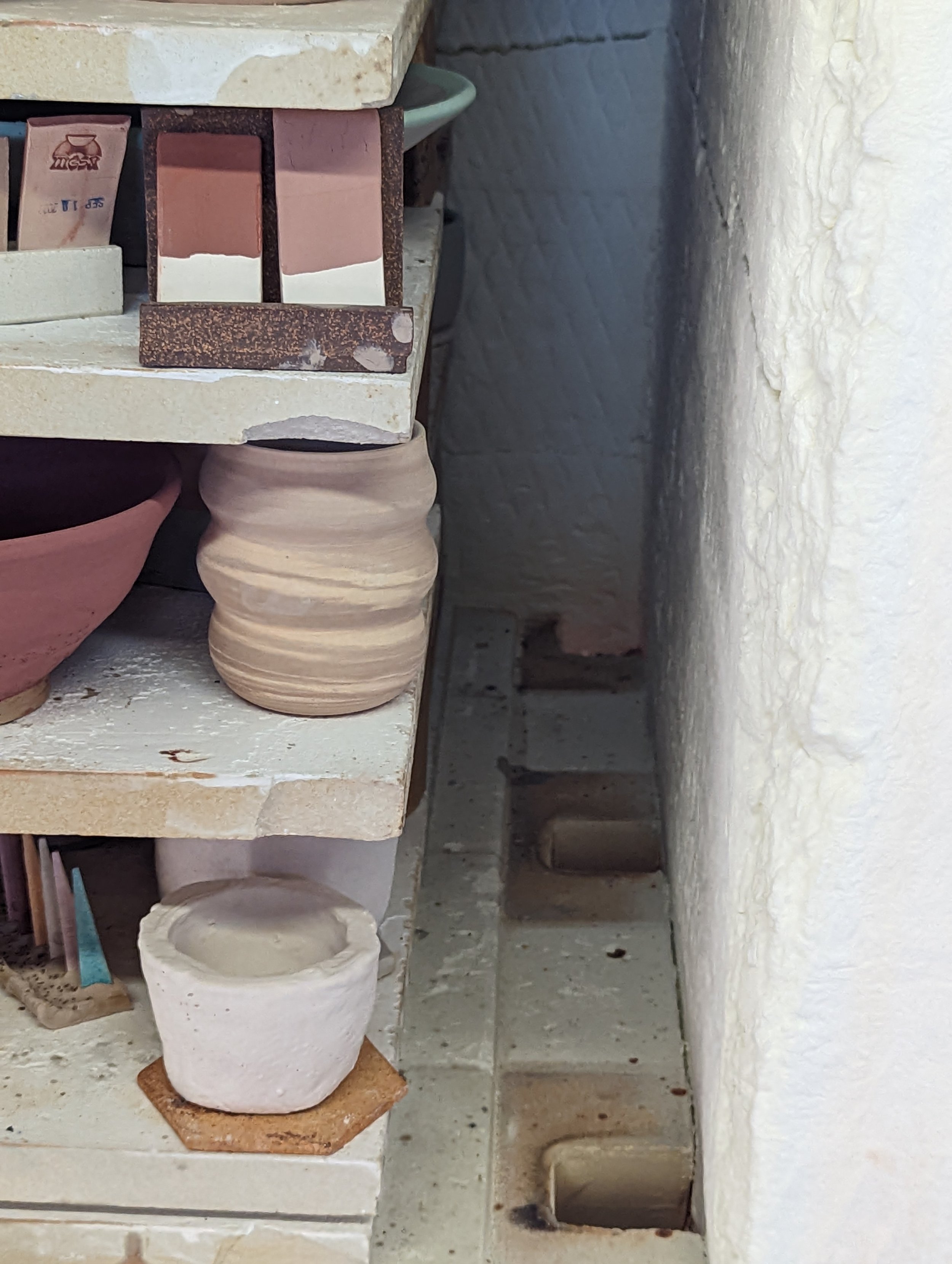Time to Light the Candle
If you hear someone say this while you are in the studio it doesn’t mean that birthday cake will soon follow, rather, it means it’s time to fire up the gas kilns. There are currently five gas kilns plus a Soda and Raku kilns in the Kiln Yard. The five work horses are affectionately known as Clayton, Hal, Olsen, Pele and Big Geil. Clayton and Pele have recently been retired to make more room in the kiln yard for a new kiln. Olsen was recently rebuilt this Spring. The rebuilding took much longer than expected, increasing the turnaround time once pieces were placed on the glazed shelves. However, the delay was worth it, Olsen is back up on its feet and running better than ever. Olsen can hold 12 cubic feet of pottery and is the only completely manual kiln that operates off of the up draft.
The remaining two workhorses are Geil kilns, Hal and Big Geil, that have a capacity of 16 and 40 cubic feet respectively. Geil kilns are modern kilns, more efficient than brick and are both automatic and manual downdraft machines. Fiber linings are thermally more efficient than brick linings. Fiber linings also have a low heat storage and the fewer BTUs needed to bring the kiln up to temperature. The BTUs required to fire is directly related to the amount of energy consumed. Thus, the fewer the BTUs consumed; the more energy conserved. All part of the Studio’s commitment to sustainability (for more on this topic see the next edition of Around the Wedging Table). Moreover, the kiln can achieve its maximum temperature more quickly and can cool down faster than kilns constructed with insulating fire brick. Shorter operating cycles increase productivity also increases the kilns longevity. Additionally, fiber heats at a more uniform rate, allowing for a more uniform temperature distribution within the kiln chamber., however, after the first 14 hours of firing staff shifts these kilns into manual mode and lovingly attend to them for the balance of the firing schedule.
Although Clayton and Pele have been retired, the three remaining kilns are on a regular and consistent firing schedule turning pieces around on relatively short order. Thanks to the generosity of a member, who prefers to remain anonymous, another Geil kiln will soon join the existing stable of studio workhorses. However, since it is currently being custom built the ETA is October 18th, and once it arrives it will increase firing capacity by another 30 cubic feet. Although retiring Pele and Clayton may cause some delay in the turnaround time for glazed pieces as we approach the end of the year, if everyone is considerate about the amount and timing of their firing, we should be able to get through this holiday season with ease. TIP: Don’t wait until November to start firing your holiday pieces. The demand on the kilns will be at its peak between student work and holiday firing. The prudent potter will make sure to complete their holiday firing as the time crunch between Thanksgiving and the Holiday Sale is intense and the demands on firing increase exponentially. So word to the wise, so get as much fired as you can between now and Thanksgiving.
Sante, Paige and Siegfried make up the team that is responsible for lighting the candle, yet the entire studio team work together loading and unloading the kilns. The three work in teams of two taking turns shadowing each other through the firing process. This system ensures there is another brain and another set of eyes focusing on the firing. While one team member has the primary responsibility of lighting the candle and placing the load into reduction and monitoring the load through cruising and cool down, the other team member provides support and steps in when necessary and checks to make sure all steps in the process are followed. It is like a pas de deux where all the focus is on one dancer but the performance is not complete without the assistance and support of the other dancer who is just as strong, dynamic and capable of performing solo.
Once the team lights the candle, the magic begins. TPS follows a tried and true process and does not deviate from the firing steps. “If it ain’t broke, don’t fix it.” After the kilns are carefully loaded to capacity, at 5:00 pm the team meets to “light the candle” this means the automatic kilns are set to 1640 degrees and the damper is set at 3 inches before every step related to firing is carefully followed and the doors are shut to allow the kilns to climb, overnight (14 hours), to the desired temperature. The kilns are then placed in a 3-4 hour “soak” which simply means they are allowed to sit in the temperature of 1640 before placing the load into reduction. Although it is automatically set for a 3-4 hour soak, in reality “soak” only occurs for approximately 1 hour before the kiln is placed in reduction. Reduction occurs when the gas is turned up high and oxygen is reduced by pushing the damper in to about 2 ¼ inches. The kilns will remain in reduction for 2 hrs. always starving the load of oxygen. When the expertly Paige prepared cone pack starts to bend at Cone 7, the team begins its focused monitoring of the load. Regularly checking the cones, the color and the atmosphere within the kiln to determine how much oxygen to allow back in by adjusting the damper a ¼ inch at a time over the course of the next 3 hours. The load will now “cruise” for 4 hours and eventually go into “cool down” for two days before it can safely be unloaded.
While this firing process is followed each time to the “T”, other factors go into creating successful firing. First, the team has years of individual and collective firing experience. Second, they have a passion for firing that can’t be quantified. Each team member, including those that carefully load and unload each kiln take their responsibility seriously and try to place items in the kiln in a manner that will result in the best effects based on the glaze and the clay body. Limiting your pieces to 27” in height will really assist staff and TPS community in maximizing firing efficiency and kiln space. This simple consideration can have a huge impact on the overall firing process. Another factor that contributes to the overall consistent success of the firing are the cone pacts that Paige meticulously prepares with amazing accuracy. There are two cone packs placed in every kiln, one at the top and one at the bottom. These packs are placed on the output shelves at the top and the bottom so that you know what happened in the kiln where your piece was fired. The team is committed to sharing this transparency with you to provide you with even more data for your pottery journey. While the goal is to fire at 10+, these cone packs will tell you what actually occurred in each load. Fourth, while the team is monitoring the firing, they are looking for a certain smell, flame or atmosphere to tell them how to adjust the damper. Finally, in placing items in the kiln the team may also consider the optimum placement for certain clay bodies and glazes although the overall process was developed to provide a blanket of consistent heat for a range of clay bodies and glazes.
The team recognizes there are a lot of variables that influence a successful firing and each kiln has its own unique reaction that may require an adjustment or two. However, all agree that it is important to check, double check and check again and that it is okay to be neurotic about the steps because it is perfect practice that makes perfect not just practice. Clearly, there is a lot of thought, patience and passion that goes into lighting the candle and we are clearly in the best hands with this team of candle lighters.
POSTSCRIPT: In addition to the gas kilns there are 12 electric kilns. Kilns A-F are strictly for Studio use, for bisque firing and mid-fire glazeware. While electric kilns G-L can be reserved by members who want the flexibility and control of firing their own low and mid-fire work.
The Potters’ Studio recently replaced 4 electric kilns thanks to the generous donation of the member who prefers to remain anonymous. This member also donated the new Geil gas kiln. Thanks to the member’s amazing generosity the candle will be lit without interruption for years to come.
Training on firing the gas kilns has begun again and there is a weekly training on loading and firing the electric kilns as well. If interested, sign-up and become better acquainted with the workhorses of the studio. Lighting the candle will take on a whole new meaning for you now that you know the steps to the firing choreography.







